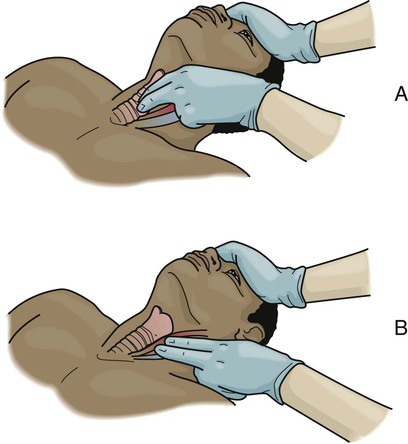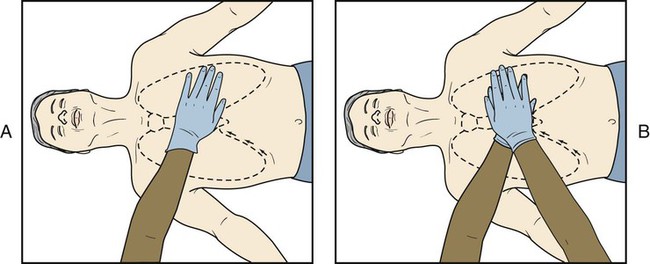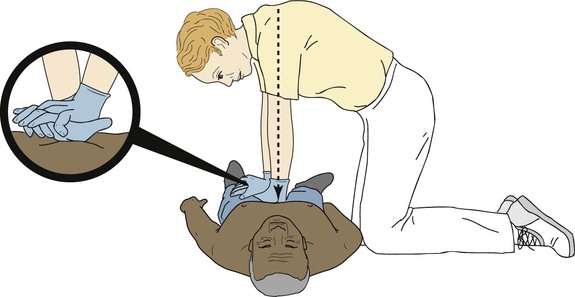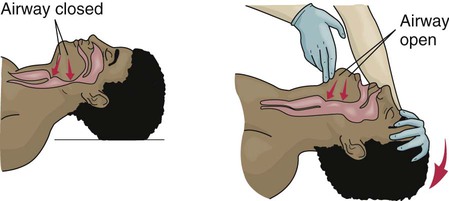AED Automated external defibrillator AHA American Heart Association CPR Cardiopulmonary resuscitation EMS Emergency Medical Services • Define the key terms and key abbreviations listed in this chapter. • Describe the rules of emergency care. • Identify the signs of cardiac arrest and the emergency care required. • Describe the signs, symptoms, and emergency care for hemorrhage. • Identify the common causes and emergency care for fainting. • Identify the signs, symptoms, and emergency care for shock. • Describe the signs, symptoms, and emergency care for stroke. • Explain the causes and types of seizures and how to care for a person during a seizure. • Identify the common causes and emergency care for burns. • Perform the procedures described in this chapter. • Explain how to promote PRIDE in the person, the family, and yourself. Each emergency is different. The rules in Box 31-1 apply to any emergency. Hospitals and other agencies have procedures for emergencies. Rapid Response Teams (RRTs) are called when a person shows warning signs of a life-threatening condition. An RRT may include a doctor, a nurse, and a respiratory therapist. The RRT’s goal is to prevent death. See Focus on Communication: Emergency Care. See Promoting Safety and Comfort: Emergency Care. The AHA’s BLS courses teach the adult Chain of Survival. These actions are taken for heart attack (Chapter 28), sudden cardiac arrest, respiratory arrest, stroke (Chapter 28 and p. 493), and choking (p. 491). They also apply to other life-threatening problems. They are done as soon as possible. Any delay reduces the person’s chance of surviving. Chain of Survival actions for adults are: • Recognizing cardiac arrest and activating the EMS system at once. • Early cardiopulmonary resuscitation (CPR). • Early defibrillation. See p. 487. • Early advanced care. This is given by EMS staff, doctors, and nurses. They give drugs and perform life-saving measures. • Organized post–cardiac arrest care. This is care given to improve survival following cardiac arrest. See Focus on Communication: Chain of Survival for Adults. • No breathing or no normal breathing. The person may have agonal gasps or agonal respirations early during SCA. (Agonal comes from the Greek word that means to struggle. Agonal is used in relation to death and dying.) Agonal gasps do not bring enough oxygen into the lungs. Gasps are not normal breathing. The person’s skin is cool, pale, and gray. The person is not coughing or moving. SCA is a sudden, unexpected, and dramatic event. It can occur anywhere and at any time—while driving, shoveling snow, playing golf or tennis, watching TV, eating, or sleeping. Common causes include heart disease, drowning, electric shock, severe injury, choking (Chapter 9), and drug over-dose. These causes lead to an abnormal heart rhythm called ventricular fibrillation (p. 487). The heart cannot pump blood. A normal rhythm must be restored. Otherwise the person will die. See Promoting Safety and Comfort: CPR for Adults. Before starting chest compressions, check for a pulse. Use the carotid artery on the side near you. To find the carotid pulse, place 2 or 3 fingertips on the trachea (windpipe). Then slide your fingers down off the trachea to the groove of the neck (Fig. 31-1). Check for a pulse for at least 5 seconds but no more than 10 seconds. While checking for a pulse, look for signs of circulation. See if the person has started breathing or is coughing or moving. The heart lies between the sternum (breastbone) and the spinal column. When pressure is applied to the sternum, the sternum is depressed. This compresses the heart between the sternum and spinal column (Fig. 31-2). For effective chest compressions, the person must be supine on a hard, flat surface—floor or back-board. You are positioned at the person’s side. Hand position is important for effective chest compressions (Fig. 31-3, p. 486). You use the heels of your hands—1 on top of the other—for chest compressions. For proper placement: • Expose the person’s chest. Remove clothing or move it out of the way. You need to see the person’s bare skin for proper hand position. • Place the heel of 1 hand (usually your dominant hand) in the center of the bare chest. The heel of this hand is placed on the sternum between the nipples. • Place the heel of your other hand on top of the heel of the first hand. To give chest compressions, your arms are straight. Your shoulders are directly over your hands. And your fingers are interlocked (Fig. 31-4). Exert firm downward pressure to depress the adult sternum at least 2 inches. Then release pressure without removing your hands from the chest. Releasing pressure allows the chest to recoil—to return to its normal position. Recoil lets the heart fill with blood. The respiratory passages (airway) must be open to restore breathing. The airway is often obstructed (blocked) during SCA. The person’s tongue falls toward the back of the throat and blocks the airway. The head tilt–chin lift method opens the airway (Fig. 31-5). • Place the palm of 1 hand on the forehead. • Tilt the head back by pushing down on the forehead with your palm. • Place the fingers of your other hand under the lower jaw. Use your index and middle fingers. Do not use your thumb. • Lift the jaw. This brings the chin forward. • Do not close the person’s mouth. The mouth should be slightly open.
Assisting With Emergency Care
Key Abbreviations
Emergency Care
BLS for Adults
Chain of Survival for Adults
Sudden Cardiac Arrest
CPR for Adults
Chest Compressions.

A, Two fingers are placed on the trachea. B, The fingertips are moved down into the groove of the neck to the carotid artery.


A, The heel of the dominant hand is placed in the center of the chest between the nipples. B, The heel of the non-dominant hand is placed on top of the dominant hand.

Airway.

![]()
Stay updated, free articles. Join our Telegram channel

Full access? Get Clinical Tree


Assisting With Emergency Care
Get Clinical Tree app for offline access
